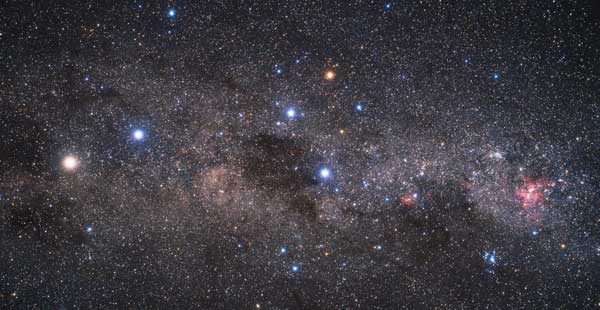
Akira Fujii
Sending a research mission to even the closest star system will not be possible for a long time, if ever. But what if material from, say, Alpha Centauri were zooming by Earth, ready to be studied? That may actually be the case, according to planetary scientist Cole Gregg (University of Western Ontario, Canada).
Gregg calculated the fate of objects expelled from the Alpha Centauri system, 4.3 light-years from Earth, and roaming the Milky Way galaxy for millions of years. His preliminary conclusion, using a simplified model of the Milky Way, is that a small fraction, 0,03 percent, could reach the Solar System and, importantly, be recognized as coming from that nearby system. Gregg presented his findings at the recent meeting of the American Astronomical Society’s Division for Planetary Sciences in Boise, Idaho.
So far, only two objects have ever been determined, from their trajectories, to be visitors from interstellar space: 1I/ʻOumuamua (discovered in 2017) and 2I/Borisov (discovered in 2019). However, Gregg says, it’s impossible to back-calculate those trajectories to a specific star system. “If even very small changes to their velocity and direction are propagated back millions or hundreds of millions of years, it’s a very broad area they could be coming from,” he notes.
Instead, his model starts from the other end, by calculating how objects would fare after they are expelled in random directions from a known nearby star system. In the case of Alpha Centauri, the main driver of any expulsions would be the gravitational tug-of-war between the three stars that comprise the system.
“We know that star systems can eject material,” Gregg says. “It can be anywhere from smaller grains all the way up to kilometer sized bodies like comets and asteroids.” Each of those objects would continue to orbit around the Milky Way, just like Alpha Centauri and our solar system do.
Gregg concentrated his modeling on objects with slower ejection speeds, which would stay closer to the orbit of their parent star system. “They go through a process called orbital shear, and it’s causing them to stretch out in a sort of stream,” Gregg explains. “They have very similar properties in their orbital velocities and positions.” As a consequence, when members of that stream are detected near Earth, those properties would reveal their membership and thus their origin.
“The idea by Gregg seems to be very interesting and opens the way for further investigations,” says Mária Hajduková (Slovak Academy of Sciences), who was not involved with the study. “It is reasonable to expect that a meteoroid stream from another planetary system may contribute to the material observed in our solar system. However, any predictions must consider the dispersion of the stream during its evolution, as well as the survival of its particles.”
That is exactly what Gregg plans to do in a follow-up study, using a more detailed model of the Milky Way. He will also include the effects of the interstellar environment on the Alpha Centauri material, to see what size material might be incoming. “This will give us an estimate on whether or not we think that small grains could have survived, and we could see them as meteors,” he says, “or if it’s more likely to be larger objects that are more likely to be detected observationally through telescope surveys.”
For any objects that apparently come from outside the solar system, astronomers will also have to take into account how the gravity of the Sun and Earth changed their trajectories after arriving. Only then will it be possible to determine if the original trajectories flag any of them as a member of the Alpha Centauri stream.
Actual detection of such material would be exciting, says Hajduková: “If Alpha Centauri meteors were found, they might provide information about their parent system.”
“One intriguing aspect is the potential presence of prebiotic material in such interstellar material, similar to that found in chondritic solar system material,” she adds. “This would have significant implications for the possibilities of life emerging elsewhere in our Galactic neighborhood.”
Gregg emphasizes that his work is preliminary. “We are not yet ready to say that, for sure, there is material coming from Alpha Centauri and it is intersecting the solar system,” he cautions. “But we’re saying at this point that it’s a possibility.”

